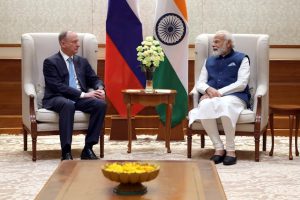Last week, a potentially consequential meeting in New Delhi went conspicuously unnoticed in much of the West. On the sidelines of a meeting of the Shanghai Cooperation Organization (SCO), Nikolai Patrushev, secretary of Russia’s powerful Security Council, met India’s Prime Minister Narendra Modi in a private interaction.
Details about what was discussed are notoriously skimpy in the public domain, but getting a meeting with Modi is no easy task and the conversation certainly had a compelling context.
Ever since the Ukraine war began, Russia’s economy has relied heavily on trade ties with India and China to keep its war effort going. The unprecedented extent of the West’s sanctions on Moscow meant that Russia’s President Vladimir Putin had to essentially build a parallel economy to sidestep dollar transactions and keep those ties going.
Just so, in the aftermath of the invasion, Russia’s trade with China in the Chinese yuan multiplied by an extraordinary 80 times. At a meeting with China’s President Xi Jinping last month, Putin spoke of a longer-term plan to rely on the yuan as its currency of choice. “We are in favor of using the Chinese yuan for settlements between Russia and the countries of Asia, Africa, and Latin America,” he said.
That plan will also have to include India at some point. Owing to accelerated oil purchases since the invasion, India’s imports from Russia have multiplied by a whopping 400 percent over this past fiscal year. Russia is now India’s fourth-largest trade partner and still surging (it was the seventh-largest only in October). It’s no surprise then that Patrushev had been accompanied on his trip by the chairman of Rosneft, Russia’s state-owned oil company, who signed an agreement with the Indian Oil Corporation to increase supplies.
Meanwhile, in a separate meeting in New Delhi, the Deputy Chairman of the State Duma — the lower house of Russia’s parliament — floated a common digital currency led by India, China and Russia. And last week, Russia’s latest foreign policy concept note mentioned India and China as its closest allies.
All that sounds quite sensible from Moscow’s point of view. The problem for Putin, however, is that India still views China suspiciously, owing to lengthy clashes on the border, and it’s highly unlikely just yet that New Delhi would be willing to work with Beijing to build a parallel economy free from the dollar. After deadly border clashes broke out in 2020, India cracked down on sundry Chinese smartphone apps and investors. Last year, it launched various tax evasion probes against Chinese businesses. That general trend of economic decoupling also owes at least in part to Modi’s protectionist zeal in building domestic manufacturing.
Yet, none of this is to say that India doesn’t want to challenge the dollar’s global dominance. Concerns over Western hegemony are a bigger part of India’s strategic culture than most in Washington might think, and the West’s sweeping use of economic sanctions has unsettled many in New Delhi over the years. Last year, India’s central bank, the Reserve Bank of India, permitted rupee trade, thereby facilitating stronger ties with countries under Western sanctions.
But if Putin is to use this convergence of interests to keep his parallel economy going, he will have to find a way to ease tensions between Beijing and New Delhi on their Himalayan border.
Many are skeptical that Putin can prevail on Xi to do that; the balance of power in that lopsided alliance is well and truly with the Chinese. Yet, the border with India is also increasingly becoming a footnote in China’s own strategic priorities as it sets its eyes on bigger prizes on the global stage. Over the last several months, China has been positioning itself as a strategic alternative to the U.S., everywhere from Ukraine to the Pacific and the Middle East. As tensions heat up around Taiwan, Beijing is increasingly shifting its focus to building resilience against potential economic blowback from the West.
If Putin is able to appeal to those larger ambitions when he likely meets Modi and Xi at the SCO and perhaps the G-20 later this year, a new bloc may be forming in the East. That’s a trend that everyone in Washington should be following far more closely.

































